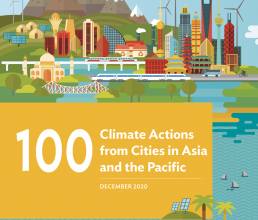First appeared in

Asian Development Bank
100 Climate Actions from Cities in Asia and the Pacific
ADB has implemented several retrofits to their headquarters in Manila to reduce energy and water consumption, lower greenhouse gas emissions, and win Gold certification for Leadership in Energy and Environmental Design (LEED).
ADB has implemented several retrofits to their headquarters in Manila to reduce energy and water consumption, lower greenhouse gas emissions, and win Gold certification for Leadership in Energy and Environmental Design (LEED).
Over the past six years, the ADB headquarters has undergone a number of changes to improve the environmental performance of the building in Mandaluyong City, Metro Manila. The changes have resulted in a recertification under the United States Green Building Council’s LEED Existing Building Operations and Maintenance — achieving the LEED Gold certification.
47%
REDUCTION IN CO₂ EQUIVALENT EMISSIONS FROM 2013 TO 2016
In 2014, ADB switched the energy that powers the building away from conventional sources to renewables. Now, the building’s power comes from a mix of geothermal (96%) and solar energy (4%) from photovoltaic panels on the roof.
There has also been a focus on water, with internal recycling and rainwater harvesting helping to reduce demand for potable water, as well as water efficient appliances reducing water consumption.
As a result of the building changes made, annual emissions totaled 10,913.52 tons of carbon dioxide equivalent in 2016, 46.8% lower than in 2013. To fully offset the remaining emissions, ADB purchased 12,000 carbon credits from a 50.4 MW wind farm in Maharashtra, India.

The ADB headquarters in Mandaluyong City, Metro Manila, achieved Gold LEED certification (photo by ADB).
The Challenge
As a highly urbanized area, Mandaluyong experiences environmental problems often associated with urbanization such as air and water pollution, flooding, solid waste management issues and climate change.
Co-Benefits
Economics Reduced power intensity as well as lower water and paper consumption has resulted in reduced operational expenses.
Social ADB has committed to employ best practices, safe operating procedures, and appropriate technologies to eliminate health and safety risks to its personnel at the workplace.

